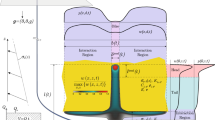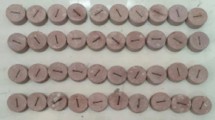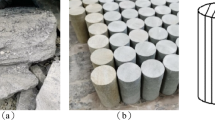Abstract
A general initial water penetration (seepage) fracture criterion for concrete is proposed to predict whether or not harmful water penetration (hydraulic fracturing), other than microcracking, will occur in concrete structures in a severe high water pressure environment. The final regression, of the different macroscopic failure types in concrete to microscopic Mode I cracking, allows the use of only one universal criterion to indicate the damage. Thus, a general initial water penetration fracture criterion is approximately defined as a strain magnitude of 1000×10−6, based on the concept of tensile strain derived from experimental results in the relevant literature. Then, the locations of harmful water penetration fracture (hydraulic fracture) in the high arch dam mass of the Jinping first class hydropower project are analyzed using the nonlinear finite element method (FEM) according to the proposed criterion. The proposed criterion also holds promise for other concrete structures in high water pressure environments.
Similar content being viewed by others
References
Bryzgalov V I, Gaziev É G. Behavior of the dam of the Sayano-Shushenskaya Hydropower Plant before and after reconditioning. Power Technol Eng, 2004, 38(2): 84–88
Goela R K, Jethwaa J L, Paithankar A G. Tunneling through the young Himalayas — A case history of the Maneri-Uttarkashi power tunnel. Eng Geol, 1995, (39): 31–44
Chen W F, Saleeb A. Constitutive Equations for Engineering Materials. New York: Wiley Interscience, 1994
Yu M H. Theory of Strength of Concrete and Its Application (in Chinese). Beijing: Higher Education Press, 2002
Laham S AI. Stress Intensity Factor and Limit Load Handbook. East Kilbride: British Energy Generation Ltd, 1998
Li Z J, Shah S P. Localization of microcracking in concrete under uniaxial tension. ACI Mater J, 1994, 91(4): 372–381
Carino N J, Slate F O. Limiting tensile strain criterion for failure of concrete. J Am Concrete Institute, 1976, 73(3): 160–165
Kaplan M F. Strains and stresses of concrete at initiation of cracking and near failure. ACI J, Proceeding, 1963, 60(7): 853–880
Khaloo A R, Ahmad S H. Behavior of normal and high-strength concrete under combined compression-shear loading. ACI Mater J, 1988, 85(6): 551–559
Shah S P, Chandra S. Critical stress, volume change, and micro-cracking of concrete. ACI J, Proceeding, 1968, 64(9): 770–780
Samaha H R, Hover K C. Influence of microcracking on the mass transport properties of concrete. ACI Mater J, 1992, 89(4): 416–424
Evans R H, Marathe M S. Microcracking and tress-strain curves for concrete in tension. Mater Struc, 1968 (1): 61–64
Gerard B, Breysse D, Ammouche A. Cracking and permeability of concrete under tension. Mater Struc, 1996, 29: 141–151
Gerard B, Jacoben S, Marchand J. Concrete cracks II: Observation and permeability — A review. Second International Conference on Concrete under Severe Conditions 2: Environment and Loading, Throms, 1998
Gilles P, Frederic D, Marta C. Permeability due to the increase of damage in concrete: From diffuse to localized damage distributions. J Eng Mech, 2009, 135(9): 1022–1028
Zhou Z F, Wang J G. Dynamics of Fluids in Fractured Media (in Chinese). Beijing: China Water Power Press, 2004
Liu Y X, Li S J, Zhou C F, et al. Inverse analysis of permeability coefficient for fengman concrete gravity dam. J Wuhan Univ Hydr. Elec Eng, 1999, 32(1): 1–3
ABAQUS Inc. ABAQUS Theory Manual Version 6.6. Rhode Island: Dassault Systèmes Simulia Corp., 2006
Ren Q W, Xu L, Jiang Y Z, et al. Anti-cracking and stability analysis of the dam mass in the complex geological conditions. Nanjing: Hohai University, 2009
Author information
Authors and Affiliations
Corresponding author
Rights and permissions
About this article
Cite this article
Jiang, Y., Ren, Q., Xu, W. et al. Definition of the general initial water penetration fracture criterion for concrete and its engineering application. Sci. China Technol. Sci. 54, 1575–1580 (2011). https://doi.org/10.1007/s11431-011-4309-0
Received:
Accepted:
Published:
Issue Date:
DOI: https://doi.org/10.1007/s11431-011-4309-0




